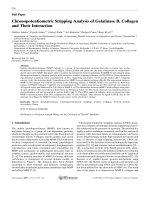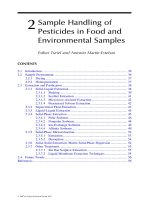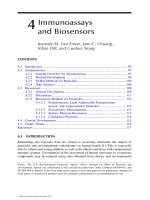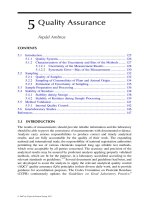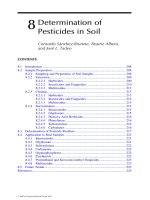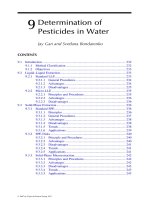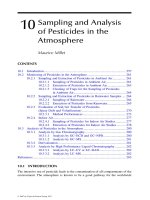Synthesis, spectral, thermal, crystal structure, Hirschfeld analysis of [bis(triamine) Cadimium(II)][Cadimum(IV)tetra-bromide] complexes and their thermolysis to CdO nanoparticles
Bạn đang xem bản rút gọn của tài liệu. Xem và tải ngay bản đầy đủ của tài liệu tại đây (4.07 MB, 11 trang )
Warad et al. Chemistry Central Journal (2016) 10:38
DOI 10.1186/s13065-016-0183-y
RESEARCH ARTICLE
Open Access
Synthesis, spectral, thermal, crystal
structure, Hirschfeld analysis of [bis(triamine)
Cadimium(II)][Cadimum(IV)tetra‑bromide]
complexes and their thermolysis to CdO
nanoparticles
Ismail Warad1*, Fuad Al‑Rimawi2, Assem Barakat3,4*, Saida Affouneh5, Naveen Shivalingegowda6,
Neartur Krishnappagowda Lokanath7 and Ibrahim M. Abu‑Reidah1
Abstract
Background: The coordination chemistry of cadmium(II) with diamine ligands is of particular interest. The most
common structure around cadmium(II) center in their complexes is tetrahedral, that is due the octet rule obeyed.
Nevertheless, five and six-coordinated complexes are also well known. Now a day, many cadmium(II) complexes with
chelate ligands were synthesized for their structural or applications properties. Antibacterial activities and DNA bind‑
ing affinity of this class of cadmium complexes have attracted considerable interest.
Results: Cadmium(II) complexes in dicationic form with general formula [Cd(dien)2]CdBr4 complex 1 (dien = dieth‑
ylenetriamine) and [Cd(dipn)2]CdBr4 complex 2 (dipn = diproylenetriamine) were prepared and elucidated there
chemical structures by elemental analysis, UV–Vis, IR, TG and NMR, additionally complex 1 structure was solved by
X-ray diffraction study. The Cd(II) cation is located in a slightly distorted octahedral geometry while Cd(IV) anion is
in tetrahedral geometry. High stability of the synthesized complexes confirmed by TG. Thermolysis of complex 1
revealed the formation of pure cubic nanoparticles CdO which was deduced by spectral analysis. The average size of
CdO nanoparticles was found to be ~60 nm.
Conclusions: Two new Cd(II) complexes of general formula [Cd(N3)2]CdBr4 were made available. The structure of
[Cd(dien)2]CdBr4 was confirmed by X-ray diffraction. Thermal, electro and spectral analysis were also investigated
in this study. The direct thermolysis of such complexes formed a cubic CdO regular spherical nanoparticle with
the ~60 nm average particle size.
Keywords: Cadmium(II) complexes, Triamine, XRD, CdO nanoparticles
Background
Cadmium(II) complexes with polydentate nitrogen
ligands, mainly polyamines, have been studied for some
time either because of their structural properties [1, 2] or
*Correspondence: ;
1
Department of Chemistry, Science College, An-Najah National
University, P.O. Box 7, Nablus, Palestine
3
Department of Chemistry, College of Science, King Saud University,
P. O. Box 2455, Riyadh 11451, Saudi Arabia
Full list of author information is available at the end of the article
their applications [3–7]. The synthesis and characterization of triamine complexes of transition and non-transition metals are of interest as they can potentially exist in
three isomeric forms, i.e. mer and fac [8, 9]. The shape
of cadmium(II) halide complex anions depending on the
number of hydrogen bonds and the cations species [2–5].
There are variable shapes of the complex anions such as
tetrahedral [10, 11], two-dimensional layered structures
[12], and complex chain structures [13–15]. Cadmium
complexes have attracted considerable interest due to
© 2016 The Author(s). This article is distributed under the terms of the Creative Commons Attribution 4.0 International License
( which permits unrestricted use, distribution, and reproduction in any medium,
provided you give appropriate credit to the original author(s) and the source, provide a link to the Creative Commons license,
and indicate if changes were made. The Creative Commons Public Domain Dedication waiver ( />publicdomain/zero/1.0/) applies to the data made available in this article, unless otherwise stated.
Warad et al. Chemistry Central Journal (2016) 10:38
Page 2 of 11
pharmacological importance including anti-microbial
agents [4], DNA binding affinity [3], and anticancer activities [5–7, 16, 17].
The design and development of novel functional materials utilizing non-covalent interactions in complexes have
attracted considerable attention [17–20]. Various weak
dispersive interactions, such as hydrogen bonding and
other weak interactions involving π-cloud of the aromatic
ring represents the backbone of self-assembly process to
stabilize the crystals [22]. Hydrogen bonding interactions
are the most reliable and widely used in building multidimensional supramolecular structures [21–23].
In the last decade, spherical shape metal oxide nanoparticles [24] composed of a mixed-ligand dinuclear and
mononuclear cadmium(II) complexes building blocks
[25–28]. We reported the synthesis and characterization
of two now dicationic cadmium(II) complexes with general formula [Cd(N3)2]CdBr4. Complex 1 used as building
block for preparation the CdO nanoparticles by direct
open atmosphere thermolysis process.
excess of the tridentate free ligands with CdBr2•2.5H2O
in EtOH under open ultrasonic atmosphere. The dicationc Cd(II) complexes were prepared in very good yield
without side products, as seen in Scheme 1.
The X-ray single crystal diffraction technique used to
confirm the structure of the target complex 1 and other
spectral analysis including elemental analysis, IR, UV–
vis, TG/DTA, CV and NMR. The isolated complexes are
stable in air, soluble only in water, DMF and DMSO. The
dicationc natural was supported by high water solubility (0.02 g/ml at RT) and molar conductance (ʌM = 190
Ω−1cm2 mol−1 of 1 × 10−3M at RT) showed that the two
complexes are electrolytic in their nature. The analytical
data of the [Cd(dien)2]CdBr4 desired complex consisted
with XRD analysis data. The TG-residue product of complex 1 revealed the formation of CdO cubic nanoparticle
[23]. The genital heating with fixed heat of rate as well as
the N-tridentate ligands may play the critical role in destructure of the desired complexes to CdO nanoparticles.
Results and discussion
An asymmetric unit cell consists of two Cd2+ ions of
which one is a cation and the other counter ion, two dien
fully coordinated to the Cadmium cation center. An N6
coordinated complex is formed. The Cd(II) cation are
Synthesis of the desired complexes
Two new dicationic Cd(II) complexes with general formula [Cd(N3)2]CdBr4 have been prepared by mixing of
Scheme 1 Synthesis of the desired complexes
X‑ray crystal structure of complex 1
Warad et al. Chemistry Central Journal (2016) 10:38
located in a slightly distorted octahedral geometry while
Cd(IV) counter anion are in tetrahedral geometry seen in
Fig. 1. The bond length between the Cd(IV) anions and
the bromine atoms are in the expected range except for
the elongation of Br3 atom which is actively involved
in the hydrogen bonding as seen in Fig. 2. This type of
hydrogen bonding helps in the better stabilization of the
crystal structure. A study of torsion angles, asymmetric
parameters and least-square plane calculations reveals
that one of the four five membered ring the ring adopts
an envelope conformation with the atoms N10 and N13
deviating 0.230 (3) and −0.109 (3) Å respectively from
the Cremer and Pople plane [29]. This is confirmed by
the puckering parameters Q = 0.472 (3) Å and ф = 255.5
(3). The other three five membered rings adopts a twisted
conformation on the bonds C8–C9, C15–C16 and C18–
C19 respectively. The structure exhibits both inter and
intramolecular hydrogen bonds of the N–H….Br and
C—H….Br which helps in stabilizing the crystal structure
[14, 15]. Packing of the molecules when viewed down
along the a axis indicates that the molecules exhibit
layered stacking and several hydrogen bonds as seen in
Fig. 3. The crystal data deposited and can be retrieved via
CCDC 1404033.
IR spectrum
The IR spectrum of complex 1 is depicted in Fig. 4.
Complex 1 revealed three main characteristic absorptions peaks in the range 3180–3300, 2780–2850 and
650–450 cm−1, which was assigned to N–H, C-Halkyl and
Cd–N stretching vibrations, respectively [25–27]. No
water was recorded in the structures of the complexes.
The chemical shifts of N–H functional groups of dipen
coordinated to the Cd(II) center in the complexes was
Page 3 of 11
shifted down filed by ~60 cm−1 compared by the free
one, this support the tridentate ligand full coordination
to the Cd(II) center.
UV–Vis spectral study
The UV–Vis absorption spectra of the complex 1 and
complex 2 in water solvent presented one sharp dominant bands at 270 and 280 nm respectively, no other
bands were detected elsewhere, as seen in Fig. 5. The cadmium centers showed only the charge transfer transitions
which can be assigned to charge transfer from the metal
to ligand and vice versa (d—σ* electron transfer), no
absorption resonated to π–π* electron transfer (dien and
dipn ligands are saturated) or d–d transition are expected
for d10 Cd(II) complexes [30, 31].
NMR investigation
The 1H and 13C{1H} NMR spectra of the synthesized
complexes were carried out in d6-DMSO solvent to confirm the binding of the dien ligands to the cadmium(II) in
2–1 ration respectively. The 1H and 13C{1H} NMR spectra corroborate the structure of the desired complexes as
well as the XRD; only three functional groups, 1H NMR
(d6-DMSO): d (ppm) 2.55 and 2.62 (2 br, 16H, 8CH2),
2.85 (br, 8H, 4NH2), 3.35 (br, 2H, 2NH), signals belonging
to the CH2CH2 and NH2 of dien ligand coordinated with
CdBr2 were recorded, as depicted in Fig. 6.
TG analysis
The TG of the complex was carried out in the range of
0–800 °C and 10 °C/min heating rate, typical thermal
TG curve are given in Fig. 7 which shows that there is
no coordinated or uncoordinated water in the range
0–180 °C. Also organic and inorganic contents were destructured away (to CO2, NOx gas product) from the
Cd(II) metal center in one step decomposition in range
290–500 °C with ~80 % weight loss. The final product
(20 % residue) was confirmed to be CdO by IR [32–34].
CdO nanoparticle formed by direct thermolysis of complex 1
Fig. 1 ORTEP of the complex 1 with atom labelling. Thermal ellip‑
soids are drawn at the 50 % probability level
The phase information and composition of the TG final
residue produced through open atmosphere thermolysis
of complex 1 was deduced by FT-IR, X-ray powder diffraction (XRD), EDX, SEM and TEM. The product was
characterized as CdO nanoparticles.
Figure 8 shows the IR spectrum product CdO nanoparticle, the formation of CdO nanoparticle was supported by two signs vibration at 420 and 560 cm−1
belongs to Cd=O bond, it could be useful in understanding the bonding between the Cd–O atoms [32]. All the
other vibration assigned to the starting complexes was
disappeared due to the thermal digestion of all organic
contents.
Warad et al. Chemistry Central Journal (2016) 10:38
Page 4 of 11
Fig. 2 Elongation of bond length of Br3 atom due to hydrogen bonding. The dotted lines indicate hydrogen bonds
The (111), (200) and (220) reflections are closely match
the reference CdO prepared with JCPDS file No. 05-0640,
the formation of CdO cubic crystal nanoparticle was
confirmed, see Fig. 9. The particles were found in polycrystalline structure and that the nanostructure grew in
a random orientation which confirmed by sharp peaks
from XRD data [32–36].
The size and morphology of these particles were determined by Scanning Electron Microscopy (SEM) before
and after calcination, as seen in Fig. 10a, b, respectively.
SEM image for complex 1, particles were irregular before
calcination, while after calcination regular spherical particles were collected, which confirmed that tridentate
organic ligands play de-structure role during thermolysis
process [30–36]. According to this micrograph, nanoparticles with less than 100 nm in diameter were produced.
Also, TEM was carried out for the CdO nanoparticles
corresponding to the same sample above was illustrated
in Fig. 11. From TEM image, the average size of the nanoparticles found to be around 60 nm. The particles are
spherical in shape, not unlike those reported by Dong
et al. [34].
Hirshfeld surface analysis for complex 1
Crystal structure analysis of complex 1 using the cif
file was generated by Hirshfeld Surface, to analysis the
intermolecular interactions then illustrated the fingerprint map of atomsinside/atomoutside interactions of
molecules. The Hirshfeld surfaces of complex 1 is displayed in Fig. 12, showing surfaces that have been
mapped over a dnorm, de and di [37, 38]. “For each point
on that isosurface two distances are determined: one is
de represents the distance from the point to the nearest nucleus external to the surface and second one is
di represents the distance to the nearest nucleus internal to the surface. The dark-red spots on the dnorm surface arise as a result of the short interatomic contacts,
i.e. strong hydrogen bonds, while the other intermolecular interactions appear as light-red spots [18–22]”.
The surface here in this work represents the circular
depressions (deep red) visible on the Hirshfeld surface
indicative of strong hydrogen bonding contacts of types
N–H….Br and C—H…..Br.
The two-dimensional fingerprint plots over the Hirshfeld surfaces of complex 1 illustrate the significant differences between the intermolecular interaction patterns.
H…all (64.6 %), Br…all (34.4 %), Cd…all (0.6 %) and all…
all (Fig. 13) and Table 1.
Table 1 illustrate the detail fingerprints intermolecular interaction between inside and outside atoms in both
neighbor molecules.
Experimental section
Material and instrumentation
“Dien, dipn ligands and CdBr2•2.5H2O were purchased
from Fluka. Elemental analyses were carried out on an
Warad et al. Chemistry Central Journal (2016) 10:38
Page 5 of 11
Fig. 3 A crystal packing of complex 1 exhibiting layered stacking when viewed (perspective) along the crystallographic a axis. The dotted lines
indicate hydrogen bonds
Fig. 5 UV–Vis spectrum of the complex 1 in water at RT
Fig. 4 IR-KBr disk spectra of the complex 1
Warad et al. Chemistry Central Journal (2016) 10:38
Page 6 of 11
Fig. 6 1H NMR spectrum of the complex 1 in DMSO at RT
Fig. 9 Powder XRD pattern of CdO prepared by direct thermolysis of
the complex 1
110
by using a TU-1901double-beam UV–visible spectrophotometer. TG/DTA spectra were measured by using
a TGA-7 Perkin-Elmer thermogravimetric analyzer.
The obtained nanoparticles were examined by a Bruker
D/MAX 2500 X-ray diffractometer with Cu K radiation (λ = 1.54 Å), and the operation voltage and current
were maintained at 40 kV and 250 mA, respectively. The
transmission electron microscopy was (TEM, 1001 JEOL
Japan). The scanning electron microscopy (SEM, JSM6360 ASEM, JEOL Japan). The Hirshfeld surfaces analysis
of complex 1 was carried out using the program CRYSTAL EXPLORER 3.1 [39]”.
100
90
Wt%
80
70
60
50
40
30
20
0
200
400
Temp.oC
600
800
Fig. 7 TG thermal curve of complex 1
In an ultrasonic open atmosphere media, a mixture of
CdBr2•2.5H2O (2.0 mmol) in distilled ethanol (15 mL)
and the free ligand was added in excess (6.0 mmol).
The reaction mixture was subjected to ultrasonic
vibration until the product complex appeared as white
precipitate after ~20 min. The product was filtered
and washed several times with ethanol. The product was only soluble in water, DMF and DMSO. Single crystals suitable for X-ray diffraction experiments
were obtained by slow evaporation of water from complex solution.
90
80
T%
70
60
50
40
30
4000
3500
3000
2500
2000
General procedure for the preparation of the desired
complexes
1500
Wavenumber cm-1
1000
500
Fig. 8 IR spectra of CdO nanoparticles produced by thermolysis of
complex 1
ElementarVario EL analyzer. The IR spectra for samples
were recorded using (Perkin Elmer Spectrum 1000 FT-IR
Spectrometer). The UV–visible spectra were measured
Complex 1
Yield: (91 %). Anal. Calc. for C8H26Br4Cd2N6: C, 12.80; H,
3.49; N, 11.19 %. Found. C, 12.53; H, 3.61; N, 11.28 %. MS
[M+2] = 320.0 [theoretical = 320.2 m/z]. UV–Vis bands
in water 275 nm. m.p 340 °C. Conductivity in DMF: 18.3
(µS/cm). 1H NMR (d6-DMSO): d (ppm) 2.55 and 2.62
(2br, 16H, 8CH2), 2.85 (br, 8H, 4NH2), 3.35 (br, 2H, 2NH),
13 1
C{ H} NMR (d6-DMSO):d (ppm) 25.2 (s, 4C, CH2), 34.5
(s, 4C, CH2).
Warad et al. Chemistry Central Journal (2016) 10:38
Page 7 of 11
Fig. 10 The SEM image of complex 1 a before and b after calcination to produce CdO nanoparticles
Fig. 11 TEM image of CdO nanoparticles of an average diameter
of ~60 nm
Fig. 12 dnorm mapped on hirshfeld surface for visualizing the inter‑
contacts of complex 1
Complex 2
Crystallography
Yield: (88 %). Anal. Calc. for C12H34Br4Cd2N6: C, 17.86;
H, 4.25; N, 10.42 %. Found. C, 17.48; H, 4.21; N, 10.38 %.
MS [M+2] = 376.0 [theoretical = 376.19 m/z]. UV–Vis
bands in water 285 nm. m.p 320 °C. Conductivity in
DMF: 22.3 (µS/cm). 1H NMR (d6-DMSO): d (ppm) 1.85
(br, 8H, 4CH2), 2.62 and 2.82 (2 br, 16H, 8CH2), 2.88
(br, 8H, 4NH2), 3.38 (br, 2H, 2NH), 13C{1H} NMR (d6DMSO):d (ppm) 20.0 (s, 4C, CH2), 25.8 (s, 4C, CH2), 34.9
(s, 4C, CH2).
A colourless prism shaped single crystal of dimensions
0.35 × 0.23 × 0.19 mm of the title compound was chosen for an X-ray diffraction study. The X-ray intensity
Data were collected on a Bruker APEX-II CCD area
diffractometer and equipped with graphite monochromatic MoKα radiation of wavelength 0.71073 Å at 100
(2) K. Cell refinement and data reduction were carried
out using SAINT PLUS [24]. The structure was solved
by direct methods and refined by full-matrix least
Warad et al. Chemistry Central Journal (2016) 10:38
Page 8 of 11
Fig. 13 Hirshfeld surface fingerprint of complex 1, a Hinside…all atomsoutside 64.6 %, b Brinside…all atomsoutside 34.6 %, c Cdinside…all atomsoutside
~0 %, d all atomsinside…all atomsoutside 100 %, total interactions
squares method on F2 using SHELXS and SHELXL programs [40]. All the non-hydrogen atoms were revealed
in the first difference Fourier map itself.All the hydrogen atoms were positioned geometrically and refined
using a riding model. After ten cycles of refinement,
the final difference Fourier map showed peaks of no
chemical significance and the residuals saturated to
0.0237. The geometrical calculations were carried out
using the program PLATON [41]. The molecular and
packing diagrams were generated using the software
MERCURY [42]. The details of the crystal structure
and data refinement are given in Table 2. The list of
bond lengths and bond angles of the non-hydrogen
atoms are given in Table 3. Figure 6 represents the
ORTEP of the molecule with thermal ellipsoids drawn
at 50 % probability.
Warad et al. Chemistry Central Journal (2016) 10:38
Page 9 of 11
Table 1 Inside/outside intermolecular interaction percentage by atoms
Table 3 Selected bond distances (Å) and bond angles (°)
of complex 1
100 %
Hinside
Brinside
Cdinside
Ninside
Cinside
Atoms
Length
Atoms
Houtside
41.7
32.7
0
0
0
Cd1-N14
2.346 (2)
C12-N13
1.472 (4)
Broutside
22.4
0.8
0
0
0
Cd1-N20
2.357 (2)
N14-C15
1.475 (4)
Cdoutside
0.2
0
0
0
0
Cd1-N7
2.365 (3)
C15-C16
1.516 (4)
Noutside
0
0
0
0
0
Cd1-N13
2.365 (3)
C16-N17
1.469 (4)
Coutside
0
0
0
0
0
Cd1-N17
2.410 (2)
N17-C18
1.471 (4)
Cd1-N10
2.422 (3)
C18-C19
1.512 (4)
N7-C8
1.474 (4)
C19-N20
1.476 (4)
C8-C9
1.517 (5)
Cd2-Br5
2.5721 (5)
C9-N10
1.463 (4)
Cd2-Br4
2.5809 (5)
N10-C11
1.468 (4)
Cd2-Br6
2.5835 (4)
C11-C12
1.514 (5)
Cd2-Br3
Atoms
Angle
Table 2 Crystal data and structure refinement for Ligand
and complex 1
Parameter
Value
Empirical formula
C8H26Br4Cd2N6
Formula weight
750.79
Temperature
100 (2) K
Wavelength
0.71073 Å
Crystal system, space group
Monoclinic, P21/n
Unit cell dimensions
a = 9.4335 (12) Å
b = 14.7512 (18) Å
c = 14.7815 (18) Å
β = 100.131 (2)°
Volume
2024.9 (4) Å3
Z, calculated density
4, 2.463 Mg/m3
Absorption coefficient
9.993 mm−1
F(000)
1408
Crystal size
0.35 × 0.23 × 0.19 mm
Theta range for data collection
1.97–28.28°
Limiting indices
−12≤ h ≤12, 0≤ k ≤19, 0≤l≤19
Reflections collected/unique
4969/4960 [R(int) = 0.0000]
Refinement method
Full-matrix least-squares on F2
Data/restraints/parameters
4969/0/181
Goodness-of-fit on F2
1.057
Final R indices [I >2σ(I)]
R1 = 0.0237, wR2 = 0.0468
R indices (all data)
R1 = 0.0328, wR2 = 0.0494
Largest diff. peak and hole
0.595 and −0.885 e. Å−3
Conclusions
For the first time, two new complexes [Cd(dien)2]CdBr4
and [Cd(dipn)2]CdBr4 were synthesized in good yield.
The chemical structure of [Cd(dien)2]CdBr4 was confirmed by X-ray diffraction. The Cd(II) cation center
are located in a slightly distorted octahedral geometry
while Cd(IV) anion are in tetrahedral and in high stability. Thermolysis of the complexes revealed the formation of CdO cubic nanoparticle, which was deduced by
XRD, FT-IR, TEM and SEM, the average size of CdO
nanoparticles found to be 60 nm.
Atoms
Length
2.6313 (5)
Angle
N14-Cd1-N20
141.05 (9)
C11-N10-Cd1
N14-Cd1-N7
88.75 (9)
N10-C11-C12
107.43 (19)
109.8 (3)
N20-Cd1-N7
90.10 (9)
N13-C12-C11
110.7 (3)
N14-Cd1-N13
91.91 (9)
C12-N13-Cd1
111.76 (19)
N20-Cd1-N13
111.72 (9)
C15-N14-Cd1
108.88 (18)
N7-Cd1-N13
142.31 (9)
N14-C15-C16
109.2 (3)
N14-Cd1-N17
74.73 (8)
N17-C16-C15
110.1 (3)
N20-Cd1-N17
74.29 (9)
C16-N17-C18
114.7 (2)
N7-Cd1-N17
125.05 (9)
C16-N17-Cd1
107.94 (18)
107.01 (18)
N13-Cd1-N17
91.21 (9)
C18-N17-Cd1
N14-Cd1-N10
121.49 (9)
N17-C18-C19
109.7 (3)
N20-Cd1-N10
95.39 (9)
N20-C19-C18
109.4 (3)
N7-Cd1-N10
73.99 (9)
C19-N20-Cd1
110.46 (18)
N13-Cd1-N10
73.68 (9)
Br5-Cd2-Br4
109.305 (14)
N17-Cd1-N10
157.38 (9)
Br5-Cd2-Br6
108.258 (14)
C8-N7-Cd1
110.03 (19)
Br4-Cd2-Br6
111.585 (14)
N7-C8-C9
109.8 (3)
Br5-Cd2-Br3
111.083 (13)
N10-C9-C8
110.6 (3)
Br4-Cd2-Br3
104.874 (13)
C9-N10-C11
114.8 (3)
Br6-Cd2-Br3
111.720 (16)
C9-N10-Cd1
108.82 (19)
Supplementary material
Crystallographic data for complex 1 has been deposited
with the Cambridge Crystallographic Data Centre as supplementary publication number CCDC 1404033. “Copies of this information may be obtained free of charge
via (or
from the CCDC, 12 Union Road, Cambridge CB2 1EZ,
UK; fax: +44-1223-336033; e-mail:
ac.uk)”.
Authors’ contributions
IW developed the synthesis, IW and IMA, undertook synthesis. FA help in
analysis and interpretation of data collected and involved in drafting of
manuscript. AB carried out some physical measurements. SA revision of draft
for important intellectual content. NS and NK carried out the X-ray diffraction
Warad et al. Chemistry Central Journal (2016) 10:38
measurement and help in writing the manuscript. All authors read and
approved the final manuscript.
Author details
1
Department of Chemistry, Science College, An-Najah National University,
P.O. Box 7, Nablus, Palestine. 2 Chemistry Department, Faculty of Science
and Technology, Al-Quds University, P.O. Box 20002, Al‑Quds, Palestine.
3
Department of Chemistry, College of Science, King Saud University, P. O.
Box 2455, Riyadh 11451, Saudi Arabia. 4 Department of Chemistry, Faculty
of Science, Alexandria University, Ibrahimia, P.O. Box 426, Alexandria 21321,
Egypt. 5 Elearning Center, An-Najah National University, P.O. Box 7, Nablus,
Palestine. 6 Institution of Excellence, VijnanaBhavan, University of Mysore,
Manasagangotri, Mysore 570 006, India. 7 Department of Studies in Physics,
University of Mysore, Manasagangotri, Mysore 570 006, India.
Acknowledgements
The authors would like to extend their sincere appreciation to the Dean‑
ship of Scientific Research at King Saud University for its funding this
Research group NO (RGP-257-2015).
Competing interests
The authors declare that they have no competing interests.
Received: 17 March 2016 Accepted: 18 May 2016
References
1. Mitzi DB (2001) Templating and structural engineering in organic–inor‑
ganic perovskites. J Chem Soc Dalton Trans 1:1–12
2. Martınez-Manez R, Sancenon F, Biyikal M, Hecht M, Rurack K (2011) Mim‑
icking tricks from nature with sensory organic–inorganic hybrid materials.
J Mater Chem 21:12588–12604
3. Rakibuddin M, Gazi S, Ananthakrishnan R (2015) Iron (II) phenanthrolineresin hybrid as a visible light-driven heterogeneous catalyst for green
oxidative degradation of organic dye. Catal Commun 58:53–58
4. Schoch TK, Hubbard JL, Zoch CR, Yi GB, Sørlie M (1996) Synthesis and
structure of the ruthenium (II) complexes [(η-C5Me5)Ru(NO)(bipy)]2+
and [(η-C5Me5)Ru(NO)(dppz)]2+. DNA cleavage by an organometallic
dppz Complex (bipy = 2, 2′-bipyridine; dppz = dipyrido [3, 2-a: 2′, 3′-c]
phenazine). Inorg Chem 35:4383–4390
5. Kelland LR (2005) Overcoming the immortality of tumour cells by
telomere and telomerase based cancer therapeutics–current status and
future prospects. Eur J Cancer 41:971–979
6. Song YM, Lu XL, Yang ML, Zheng XR (2005) Study on the interaction of
platinum(IV), gold(III) and silver(I) ions with DNA. Transit Metal Chem
30:499–502
7. Zhang QL, Liu JG, Chao H, Xue GQ, Ji LN (2001) DNA-binding and photo‑
cleavage studies of cobalt(III) polypyridyl complexes:[Co(phen)2IP]3+ and
[Co(phen)2PIP]3+. J Inorg Biochem 83:49–55
8. Searle GH, House DA (1987) Lichens and fungi. XVIII. Extractives from
Pseudocyphellaria rubella. Aust J Chem 40:361–372
9. Cannas M, Marongiu G, Saba G (1980) Structures of the complexes of
CdCl2 with the aliphatic triaminesbis(2-aminoethyl)amine, bis(3-amino‑
propyl)amine, and 2-aminoethyl-(3-aminopropyl) amine: influence of
aliphatic chain length on molecular association. J Chem Soc Dalton Trans
11:2090–2094
10. Ishihara H, Dou SQ, Horiuchi K, Krishnan VG, Paulus H, Fuess H, Weiss
A (1996) Isolated versus condensed anion structure: the influence of
the cation size and hydrogen bond on structure and phase transi‑
tion in MX42− complex salts. 2,2-Dimethyl-1,3-propanediammonium
tetrabromocadmate(II) monohydrate, DimethylammoniumTetrabromozi
ncate(II), and DimethylammoniumTetrabromocadmate(II). Z Naturforsch
51a:1027–1036
11. Ishihara H, Horiuchi K, Dou SQ, Gesing TM, Buhl JC, Paulus H, Fuess H
(1998) Isolated versus condensed anion structure IV: an NQR study and
x-ray structure analysis of [H3N(CH2)3NH3]CdI4˖2H2O, [H3CNH2(CH2)3NH3]
CdBr4, [(CH3)4N]2CdBr4, and [(CH3)3S]2CdBr4. Z Naturforsch 53a:717–724
Page 10 of 11
12. Ishihara H, Krishnan VG, Dou SQ, Weiss A (1994) Bromine NQR and crystal
structures of TetraaniliniumDecabromotricadmate and 4-methylpyri‑
dinium tribromocadmate. Z Naturforsch 49a:213–222
13. Ishihara H, Krishnan K, Dou SQ, Gesing TM, Buhl JC, Paulus H, Svoboda I,
Fuess H (1999) Isolated versus condensed anion structure V: x-ray struc‑
ture analysis and 81Br NQR of t-butylammoniumtribromocadmate(II)-1/2
water, i-propylammoniumtribromocadmate(II), and tris-trimethylammoni
umheptabromodicadmate(II). Z Naturforsch 54a:628–636
14. Ishihara H, Horiuchi K, Krishnan VG, Svoboda I, Fuess H (2000) Isolated
versus condensed anion structure VI: x-ray structure analysis and 81Br
NQR of GuanidiniumPentabromodicadmate(II), [Cd(NH2)3]Cd2Br5,
tris-HydraziniumPentabromocadmate(II), [H2NNH3]3CdBr5, and bisHydraziniumTetrabromocadmate(II)-tetra hydrate, [H2NNH3]2CdBr4-4H2O.
Z Naturforsch 55a:390–396
15. Ishihara H, Dou SQ, Horiuchi K, Krishnan VG, Paulus H, Fuess H, Weiss
A (1996) Isolated versus condensed anion structure II; the influence of
the cations (1,3-propanediammonium, 1,4-phenylendiammonium, and
n-propylammonium) on structures and phase transitions of CdBr2−
4 salts
A 79,81Br NQR and x-ray structure analysis. Z Naturforsch 51a:1216–1228
16. Hines CC, Reichert WM, Griffin ST, Bond AH, Snowwhite PE, Rogers RD
(2006) Exploring control of cadmium halide coordination polymers via
control of cadmium (II) coordination sites utilizing short multidentate
ligands. J Mol Struct 796(1):76–85
17. He Y, Cai C (2011) Polymer-supported macrocyclic Schiff base palladium
complex: an efficient and reusable catalyst for Suzuki cross-coupling
reaction under ambient condition. Cat Commun 12(7):678–683
18. Seth KS (2016) Tuning the formation of MOFs by pH influence: x-ray struc‑
tural variations and hirshfeld surface analyses of 2-amino-5-nitropyridine
with cadmium chloride. CrystEngComm 15:1772–1781
19. Seth KS, Sarkar D, Kar T (2011) Use of π–π forces to steer the assembly of
chromone derivatives into hydrogen bonded supramolecular layers: crystal
structures and hirshfeld surface analyses. CrystEngComm 13:4528–4535
20. Seth KS (2014) Discrete cubic water cluster: an unusual building block of
3D supramolecular network. Inorg Chem Commun 43:60–63
21. Seth KS (2014) Exploration of supramolecular layer and bi-layer architec‑
ture in M(II)–PPP complexes: structural elucidation and hirshfeld surface
analysis [PPP = 4-(3-Phenylpropyl)pyridine, M = Cu(II), Ni(II)]. J Mol Struct
1070:65–74
22. Seth KS, Saha I, Estarellas C, Frontera A, Kar T, Mukhopadhyay S (2011)
Supramolecular self-assembly of M-IDA complexes involving lone-Pair···π
interactions: crystal structures, hirshfeld surface analysis, and DFT calcula‑
tions [H2IDA = iminodiacetic acid, M = Cu(II), Ni(II)]. Cryst Growth Des
11:3250–3265
23. Warad I, Khan AA, Azam M, Al-Resayes SI, Haddad SF (2014) Design and
structural studies of diimine/CdX2 (X = Cl, I) complexes based on 2,
2-dimethyl-1, 3-diaminopropane ligand. J Mol Struct 1062:167–173
24. Warad I, Azam M, Al-Resayes SI, Khan MS, Ahmad P, Al-Nuri M, Jodeh Sh,
Husein A, Haddad SF, Hammouti B, Al-Noaimi M (2014) Structural studies
on Cd(II) complexes incorporating di-2-pyridyl ligand and the X-ray crys‑
tal structure of the chloroform solvated DPMNPH/CdI2 complex. Inorg
Chem Commun 43:155–161
25. Warad I, Al-Ali M, Hammouti B, Hadda TB, Shareiah R, Rzaigui M (2013)
Novel di-μ-chloro-bis [chloro (4, 7-dimethyl-1,10-phenanthroline)
cadmium(II)] dimer complex: synthesis, spectral, thermal, and crystal
structure studies. Res Chem Intermed 39:2451–2461
26. Barakat A, Al-Noaimi M, Suleiman M, Aldwayyan AS, Hammouti B, Hadda
TB, Haddad SF, Boshaala A, Warad I (2013) One step synthesis of NiO
nanoparticles via solid-state thermal decomposition at low-temperature
of novel aqua (2, 9-dimethyl-1, 10-phenanthroline) NiCl2 complex. Int J
Mol Sci 14:23941–23954
27. Aldwayyan A, Al-Jekhedab F, Al-Noaimi M, Hammouti B, Hadda TB, Sulei‑
man M, Warad I (2013) Synthesis and characterization of CdO nanoparti‑
cles starting from organometalic dmphen-CdI2 complex. Int J Electro‑
chem Sci 8:10506–10514
28. Macrae CF, Bruno IJ, Chisholm JA, Edgington PR, McCabe P, Pidcock E,
Rodriguez-Monge L, Taylor R, Van de Streek J, Wood PA (2008) Mercury
CSD 2.0– new features for the visualization and investigation of crystal
structures. J Appl Cryst 41:466–470
29. Cremer DT, Pople JA (1975) General definition of ring puckering coordi‑
nates. J Am Chem Soc 97:1354–1358
Warad et al. Chemistry Central Journal (2016) 10:38
30. Saghatforoush L, Aminkhani A, Ershad S, Karimnezhad GH, Ghammamy
SH, Kabiri R (2008) Preparation of zinc (II) and cadmium (II) complexes of
the tetradentate schiff base ligand 2-((E)-(2-(2-(pyridine-2-yl)-ethylthio)
ethylimino)methyl)-4-bromophenol (PytBrsalH). Molecules 13:804–811
31. Majumder A, Rosair GM, Mallick A, Chattopadhyay N, Mitra S (2006)
Synthesis, structures and fluorescence of nickel, zinc and cadmium com‑
plexes with the N, N, O-tridentate Schiff base N-2-pyridylmethylidene2-hydroxy-phenylamine. Polyhedron 25:1753–1762
32. Warad I, Abdoh M, Shivalingegowda N, Lokanath NK, Salghi R, Al-Nuri M,
Jodeh Sh, Radi S, Hammouti B (2015) Synthesis, spectral, electrochemical,
crystal structure studies of two novel di-μ-halo-bis[halo (2, 9-dimethyl-4,
7-diphenyl-1, 10-phenanthroline) cadmium(II)] dimer complexes and
their thermolysis to nanometal oxides. J Mol Struct 1099:323–329
33. Ye XR, Daraio C, Wang C, Talbot JB (2006) Room temperature solvent-free.
Synthesis of monodisperse magnetite nanocrystals. J Nanosci Nanotech‑
nol 6:852–856
34. Dong W, Zhu CS (2003) Optical properties of surface-modified CdO nano‑
particles. Opt Mater 22(3):227–233
Page 11 of 11
35. Klug HP, Alexander LE (1954) X-ray diffraction procedures for polycrystal‑
line and amorphous materials. Wiley, New York
36. Patel RN, Singh N, Shukla KK, Niclós-Gutiérrez J, Castineiras A, Vaidy‑
anathan VG, Nair BU (2005) Characterization and biological activities of
two copper(II) complexes with diethylenetriamine and 2,2-bipyridine or
1,10-phenanthroline as ligands. Spectrochim Acta Part A 62:261–268
37. Spackman MA, Jayatilaka D (2009) Design and understanding of solidstate and crystalline materials. Cryst Eng Commun 11:19–32
38. Spackman MA, McKinnon JJ (2002) Fingerprinting intermolecular interac‑
tions in molecular crystals. Cryst Eng Commun 4:378–392
39. Wolff SK, Grimwood DJ, McKinnon JJ, Jayatilaka D, Spackman MA (2007)
Crystal explorer 2.1. University of Western Australia, Perth
40. Bruker (2009) APEX2, SAINT and SADABS. Bruker AXS Inc, Madison
41. Sheldrick GM (2008) A short history of SHELX. Acta Cryst A64:112–122
42. Spek AL (2009) Structure validation in chemical crystallography. Acta
Cryst D65:148–155
